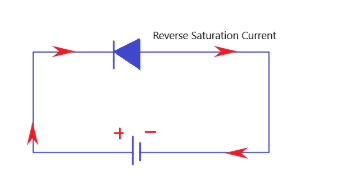
Reverse saturation current of a diode:
A.) Is independent of temperature.
B.) Increases with an increase in temperature.
C.) Decrease with an increase in temperature.
D.) May increase or decrease with an increase in temperature depending on the semiconductor.
Answer
510.6k+ views
Hint: We know that the current that flows in reverse bias PN junction diode is called reverse saturation current. From the diode current equation $I = {I_s}\left( {{e^{\dfrac{V}{{\eta {V_T}}}}} - 1} \right)$ the current should decrease as the temperature is increased but the opposite happens. This is because when the temperature is increased, more electron-hole pairs are generated and due to this the conductivity will increase, and thus current will also increase. The current doubles for every ${10^ \circ }$ rise in temperature.
Complete step-by-step answer:
When the PN junction diode is reverse biased its depletion region width increases. Majority carriers start flowing away from the junction and therefore there is no current due to majority carriers. However, there will be thermally generated electron-hole pairs, and these electrons -holes generated near the junction are known as minority carriers. The negative voltage near the P side will attract the holes (majority) and thus repel electrons (minority). Similarly, the positive voltage will attract the electrons (majority) away from the junction and repel the holes (minority).So there will be a current due to these minority carriers. Reverse saturation current is usually in terms of nano ampere to microampere. As this current is due to minority carriers and the number of minority carriers remains almost fixed at a given temperature, therefore, the current due to these minority carriers also remains constant and hence, called the reverse saturation current \[{I_{CO}}\]. This is shown in figure 1.

We know that the equation for diode current is given as
$I = {I_s}\left( {{e^{\dfrac{V}{{\eta {V_T}}}}} - 1} \right)$
As can be seen from the equation the current should be decreasing as the temperature is increasing but practically the opposite is happening. This is because when the temperature is increased, more electron-hole pairs are generated and due to this the conductivity will increase, and thus current will also increase. When the temperature increases by ${10^ \circ }$ for both germanium and silicon the reverse current will approximately get double. So option B is correct.
Note: In these types of questions we need to be well versed with the physics behind the working of PN junction diodes. We need to know about N-type and P-type semiconductor, forward bias, Reverse bias, depletion region, Majority and minority carriers, diode current equation, reverse saturation current, equation of conductivity and mobility, etc.
Complete step-by-step answer:
When the PN junction diode is reverse biased its depletion region width increases. Majority carriers start flowing away from the junction and therefore there is no current due to majority carriers. However, there will be thermally generated electron-hole pairs, and these electrons -holes generated near the junction are known as minority carriers. The negative voltage near the P side will attract the holes (majority) and thus repel electrons (minority). Similarly, the positive voltage will attract the electrons (majority) away from the junction and repel the holes (minority).So there will be a current due to these minority carriers. Reverse saturation current is usually in terms of nano ampere to microampere. As this current is due to minority carriers and the number of minority carriers remains almost fixed at a given temperature, therefore, the current due to these minority carriers also remains constant and hence, called the reverse saturation current \[{I_{CO}}\]. This is shown in figure 1.

We know that the equation for diode current is given as
$I = {I_s}\left( {{e^{\dfrac{V}{{\eta {V_T}}}}} - 1} \right)$
As can be seen from the equation the current should be decreasing as the temperature is increasing but practically the opposite is happening. This is because when the temperature is increased, more electron-hole pairs are generated and due to this the conductivity will increase, and thus current will also increase. When the temperature increases by ${10^ \circ }$ for both germanium and silicon the reverse current will approximately get double. So option B is correct.
Note: In these types of questions we need to be well versed with the physics behind the working of PN junction diodes. We need to know about N-type and P-type semiconductor, forward bias, Reverse bias, depletion region, Majority and minority carriers, diode current equation, reverse saturation current, equation of conductivity and mobility, etc.
Recently Updated Pages
Master Class 12 English: Engaging Questions & Answers for Success

Master Class 12 Economics: Engaging Questions & Answers for Success

Master Class 12 Social Science: Engaging Questions & Answers for Success

Master Class 12 Maths: Engaging Questions & Answers for Success

Master Class 12 Chemistry: Engaging Questions & Answers for Success

Master Class 12 Business Studies: Engaging Questions & Answers for Success

Trending doubts
What are the major means of transport Explain each class 12 social science CBSE

Which are the Top 10 Largest Countries of the World?

Draw a labelled sketch of the human eye class 12 physics CBSE

Explain sex determination in humans with line diag class 12 biology CBSE

The pH of the pancreatic juice is A 64 B 86 C 120 D class 12 biology CBSE

Explain sex determination in humans with the help of class 12 biology CBSE




